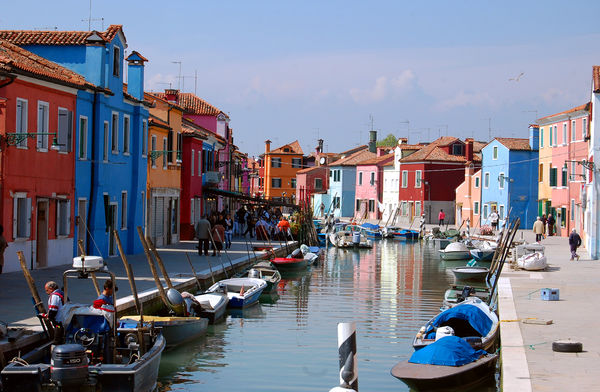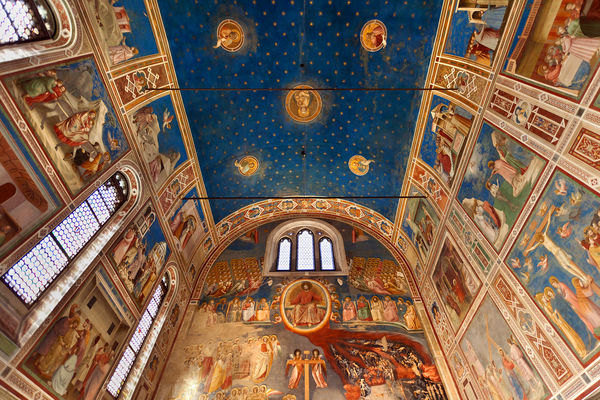Venetian Day Trips: Gems of the Veneto
By Rick Steves

I love Venice, but when the crowds become unbearable, I make it a point to get out of the center and discover what the surrounding area has to offer.
One easy escape is to the islands of Murano, Burano, and Torcello, which hide out in Venice's lagoon. Water taxis and ferry boats zip from central Venice to the islands, so you can easily see all three places in one day. Though hardly undiscovered, they provide a break from the hubbub of Venice.
The quickest-to-reach island is Murano, where, for centuries, artisans have been producing that famous Venetian glass. A 13th-century law restricted glass production (and its dangerous furnaces) to Murano to prevent fires on the main island, and also to protect the secrets of Venetian glassmaking. Today, you can visit elaborate showrooms and witness the traditional mastery of this craft in adjoining workshops.
Just as Murano is known for glass, the island of Burano, with its colorful facades gracing the lagoon, is famous for lace. Shops proudly display these painstakingly produced works of art — made with only needles and thread by artisans meticulously following time-honored patterns passed down from older generations.
Burano's vibrantly painted homes look like Venice before the plaster peeled off. As the day winds down, when shops close and the crowds return to Venice, it's worthwhile to stay and wander Burano's back lanes for a peaceful slice of the Venetian lagoon most visitors miss.
From Burano, you can head back to the mainland or stop at Torcello, the birthplace of Venice. This marshy, shrub-covered island is home to about 20 residents and the oldest church in Venice, which sports impressive mosaics.
Venice is the most famous city in a region known as the Veneto. In its heyday the island of Venice ruled a huge empire, and that included a good part of the Italian mainland. With much of the charm and far fewer crowds, you could call this region of Italy sotto-estimato — underestimated. And two of the best Veneto destinations are Padua and Verona.
Padua, half an hour from Venice by train, is home to a prestigious university, an important pilgrimage sight, and some remarkable frescoes. The city was ruled by Venice from 1405 until Napoleon came around 1800. Chafing under Venetian rule for four centuries seemed only to sharpen Padua's independent spirit. And that spirit survives at its university, which attracted intellectuals from far and wide, including Galileo, Copernicus, and Dante.
Padua has also long been a lure for pilgrims, who for nearly 800 years have flocked to the Basilica of St. Anthony. One of Christianity's most popular shrines to one of its most popular saints, the basilica is filled with magnificent art, including bronze statues of the crucifix, Mary, and Padua's favorite saints by the Renaissance master Donatello. Pilgrims visit the relics of the saint, considered miraculously preserved: his vocal chords, tongue, and jawbone. These relics befit the saint who couldn't stop teaching, preaching, and praying.
The Scrovegni Chapel is the art treasure of Padua. Nearly every inch of its glorious interior is covered by a cycle of frescoes — all painted by Giotto in the early 1300s, and beautifully preserved. Giotto, considered the first modern painter, produced scenes from the lives of Jesus and Mary that were more realistic and human than anything that had been done for a thousand years. Since the chapel is open only to a limited number of visitors a day, advanced reservations are required.
Padua also presents the opportunity to explore one of Italy's finest produce markets. Since medieval times, shoppers have come to Palazzo della Ragione and its surrounding squares for the best Veneto produce. Wandering through here, visitors can appreciate the Italian passion for good food. Merchants share recipe tips with shoppers. Locals can tell the month by the seasonal selections — artichokes and white asparagus? It's April.
At the base of the Alps and nestled in a bend of the Adige River is another leading city in the Veneto: Verona. Just over an hour away from Venice by train, Verona is famous among tourists because of its Romeo and Juliet sights, a gimmick dreamed up by a tour guide in the last century. (You can visit Juliet's famous balcony, but its connection to any romantic couple is fictitious.)
Verona is worth a visit for its history as a Roman city — an ideal last stop for ancient Romans before heading north over the Alps. Here you'll find an amazing arena — the third largest in Italy — boasting great acoustics, impressive stonework, and fine city views from the top. It's memorable to visit a theater that has hosted everything from Roman gladiator battles to rock concerts, medieval executions to opera festivals (still held every summer).
Venice is undeniably the star of this region. But you shouldn't overlook the gems nearby, with their distinctive culture and history, sumptuous art, and in-love-with-life people — embracing today with classic Italian flair.

